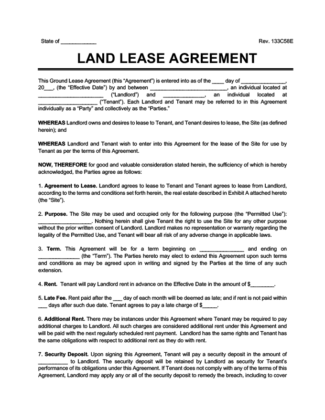
Use our Land Lease Agreement to let a tenant develop or improve land you own.

Updated June 17, 2024
Written by Josh Sainsbury | Reviewed by Susan Chai, Esq.
A Land Lease Agreement allows a person who owns a piece of land to rent that land to another person or company. Depending on the terms of the agreement, the renter can use the land for reasons such as:
A Commercial Lease Agreement or a Lease/Rental Agreement can be a helpful supplemental form for a landlord if both landlord and tenant agree to reduced rent or modified lease to accommodate specific tenant circumstances, such as job loss.
A land lease is an agreement between the owner of vacant land or property (the “landlord” or “lessor”) and an individual or entity who wants to develop or improve the property (the “tenant” or “lessee”).
The lease is for the right to occupy real estate comprised of only dirt and soil so that the tenant could use the land for multiple uses ranging from agricultural to residential or commercial purposes.
No matter how the tenant will use the land, a land lease allows both parties to clarify and memorialize essential details to avoid future disputes or confusion.
The difference between a land lease and a leasehold primarily lies in the length of the lease agreement. Land leases typically span shorter durations, ranging from six months to a couple of years. Conversely, leaseholds are known for their much longer terms, usually exceeding 25 years.
In a subordinated land lease, the property owner ranks their ownership claim below the tenant’s lenders, allowing the tenant to use the land as collateral for loans to fund improvements. This arrangement can lead to higher rent for the landlord but risks losing the land if the tenant defaults. For instance, if a property with a subordinated lease defaults on its mortgage, the lender can terminate the lease, forcing the leaseholder to leave.
Conversely, an unsubordinated land lease maintains the landlord’s priority over the tenant’s financiers, preventing the land from being used as loan collateral. This provides security for the landlord, as they retain ownership even if the tenant defaults, but typically results in lower rent. In this case, if the property owner defaults on a mortgage, the leaseholder’s rights remain unaffected, allowing continued use of the property as per the lease terms.
It’s crucial to have a comprehensive and legally binding document to protect the interests of both parties. Here are the key elements to include in a land lease agreement:
1. Names of Parties: Clearly state the full legal names and contact information of the landowner and the tenant.
2. Property Description: Provide a detailed description of the leased land, including its address, boundaries, and any structures or improvements on the land.
3. Lease Term: Specify the start and end dates of the lease term. Indicate whether the lease is for a fixed term or is renewable.
4. Rent Amount: Clearly define the rent amount, including the frequency of payments (e.g., monthly, annually) and the due date. State the method of payment and where payments should be sent.
5. Rent Escalation: If applicable, outline any rent escalation clauses that specify how and when rent may increase over the lease term. Common methods include fixed increases, percentage increases, or increases tied to the Consumer Price Index (CPI).
6. Security Deposit: Indicate the amount and whether a security deposit is required. Describe the conditions under which the deposit may be withheld or returned.
7. Use of Land: Detail the permitted uses of the land. Be specific about the activities allowed and any restrictions on land use. Specify whether any zoning or regulatory approvals are necessary.
8. Maintenance and Repairs: Specify which party is responsible for maintaining the land and any structures on it. Outline the process for requesting and performing repairs.
9. Improvements and Alterations: Define whether the tenant is allowed to make improvements or alterations to the land and, if so, the process for obtaining the landowner’s approval and any compensation or removal requirements.
10. Insurance: State the insurance requirements for both parties. This may include liability insurance, property insurance, and who is responsible for covering the costs.
11. Taxes and Utilities: Clarify which party is responsible for property taxes, utilities, and any other ongoing expenses related to the land.
12. Default and Remedies: Outline the consequences of a breach of the lease agreement, including the steps for curing a default, penalties, or termination of the lease.
13. Termination: Detail the conditions under which either party can terminate the lease, including notice periods and any penalties or compensation required.
14. Assignment and Subletting: Specify whether the tenant is allowed to assign the lease or sublet the land and the conditions under which this is permissible.
15. Access and Entry: Define the landowner’s rights to access the land for inspection or maintenance and the notice requirements.
16. Dispute Resolution: Include a clause outlining the process for resolving disputes, such as mediation or arbitration, before pursuing legal action.
17. Governing Law: Specify the jurisdiction and state laws that govern the lease agreement.
18. Signatures: Have both parties sign and date the agreement and include a clause stating that the agreement constitutes the entire understanding between the parties.
19. Attachments: Attach any necessary documents, such as surveys, site plans, or exhibits that help clarify the lease terms.
20. Legal Review: Consider reviewing the lease agreement by legal counsel to ensure it complies with local laws and regulations and adequately protects both parties’ interests.
A well-drafted land lease agreement is essential to prevent misunderstandings and disputes between the landowner and the tenant. It’s advisable to consult with legal professionals experienced in real estate law when creating or reviewing such agreements to ensure they meet all legal requirements and provide adequate protection for both parties.
For sharecropping arrangements, consult Form FSA-1940-53 Cash Farm Lease provided by the US Farm Service Agency.
Adverse possession allows a trespasser to become the land owner if they treat the property like their own for a certain number of years, ranging from five to twenty, depending on the state.
For example, the landowner, Owen, may have allowed Tim, the tenant, to farm the land without an agreement. Fifteen years later, Tim claims he owns the land, while Owen argues that he is the property owner.
Instead, Owen should have confirmed in writing that Tim is a tenant with permission to occupy the land, thereby eliminating the “hostile” requirement for an adverse possession claim.
If you are the landlord, include helpful language that protects you from any financial woes the tenant may incur while using the land by clearly stating that the land lease does not create a partnership between the landlord and tenant.
Provide the landlord’s full name or company name, depending on whether the landlord is an individual or an entity, and the tenant’s full name or company name, depending on whether the tenant is an individual or an entity. If there is more than one tenant, enter the name of each additional tenant.

Provide a legal description of the land being leased, which will be referred to as the “Site” for the rest of the agreement. A legal description is a unique description that identifies the land.

Provide the purpose and the intended use of the Site.

Provide the start date and the end date for the lease term. The term is the length of time the tenant will rent the Site.

Specify the dollar amount of each rent payment and how often the rent will be paid (i.e., on the effective date, monthly, or annually).
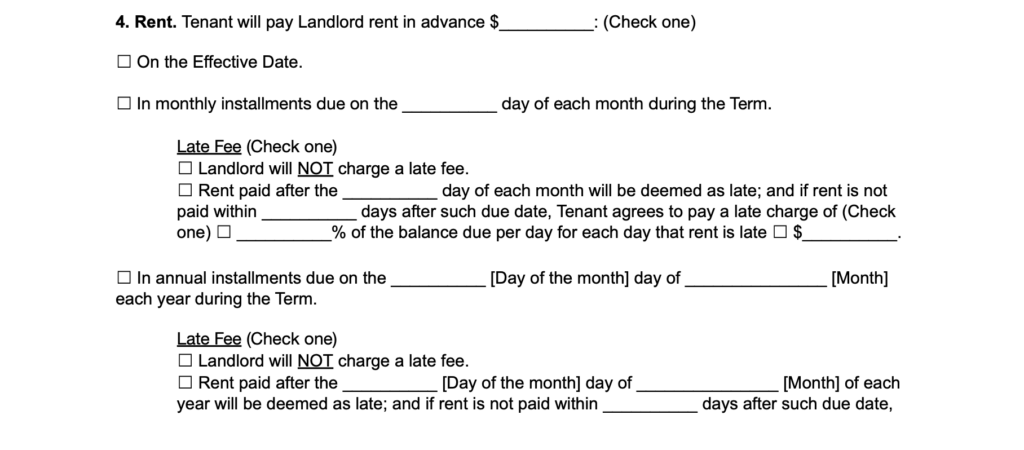
If the rent is to be paid in annual installments, select whether the rent for any portion less than one year will be calculated on a pro-rata basis.

Security Deposit Amount. Specify whether the tenant is required to pay a security deposit. If yes, provide the total dollar amount of the security deposit to be paid by the tenant to the landlord.
Security Deposit Return. Provide the number of days after the end of this agreement that the landlord will return the security deposit (less any amounts under this section) to the tenant.
Interest Bearing Security Deposit. Specify whether the security deposit will be held in an interest-bearing account.
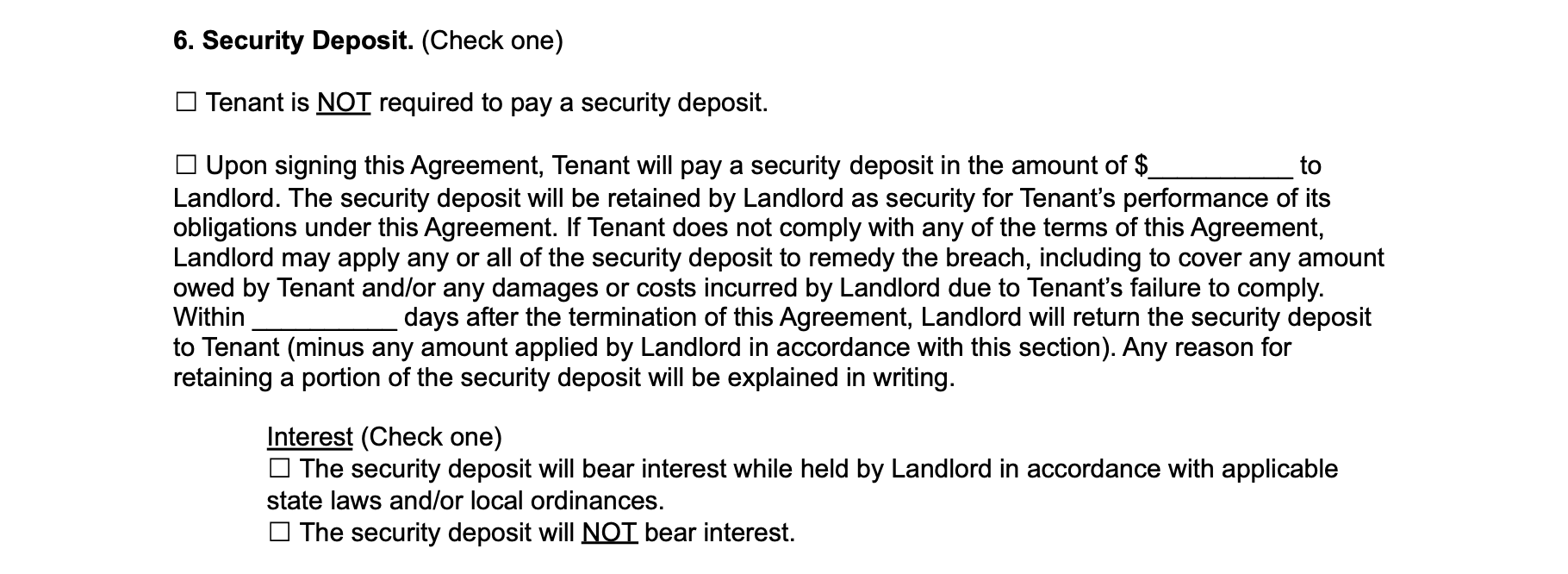
Provide whether the landlord or the tenant is responsible for paying taxes and assessments.

Provide whether the landlord or the tenant is responsible for payment of utility services such as electricity and gas.

Provide the county where this agreement will be registered with the relevant Land Registry Office. Also, provide the applicable state whose laws will govern this agreement.

If there is a holdover (tenant stays on the Site past the end of the lease term), specify the percentage of the rent per month the tenant must pay during the holdover period.


Provide whether the tenant can mortgage its leasehold interest as security for a loan and whether the landlord agrees to permit a mortgage on its interest in the Site to secure a loan payment to the tenant.

In addition to property insurance, specify whether the tenant is responsible for maintaining general liability insurance, worker’s compensation insurance, automobile liability insurance, or any other insurance. If yes, also provide the minimum coverage that must be maintained.
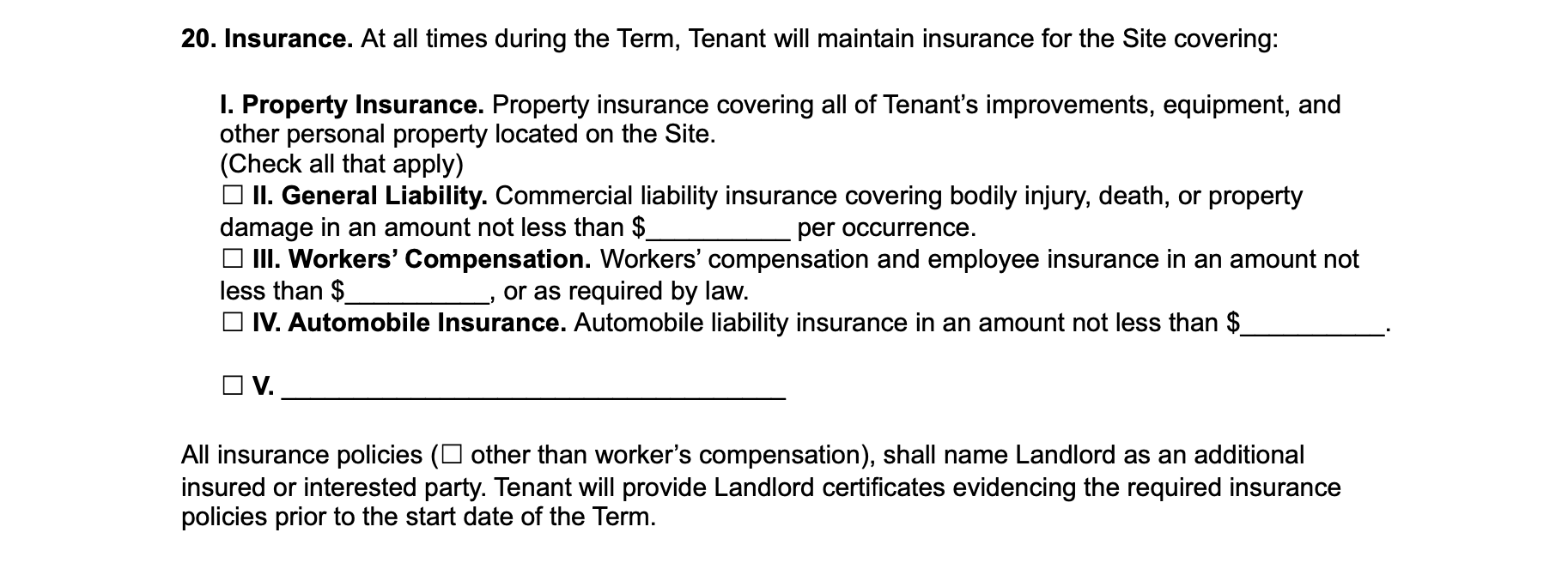
Provide for any other events of default by the tenant not already included.

Specify the number of days after receipt of the landlord’s notice of default that the landlord has to terminate this agreement.

Specify the number of days after receipt of the tenant’s notice of breach that the tenant has to terminate this agreement.

Specify the number of days after the end of this agreement the tenant has to remove all equipment, materials, and other property from the Site.
Specify the number of days after the end of this agreement that any property left on the Site can be considered abandoned by the tenant and retained by the landlord.

Choose the state’s laws that will govern this Land Lease Agreement.

If there is a dispute, specify whether the dispute will be resolved through court litigation, binding arbitration, mediation, or mediation then arbitration.
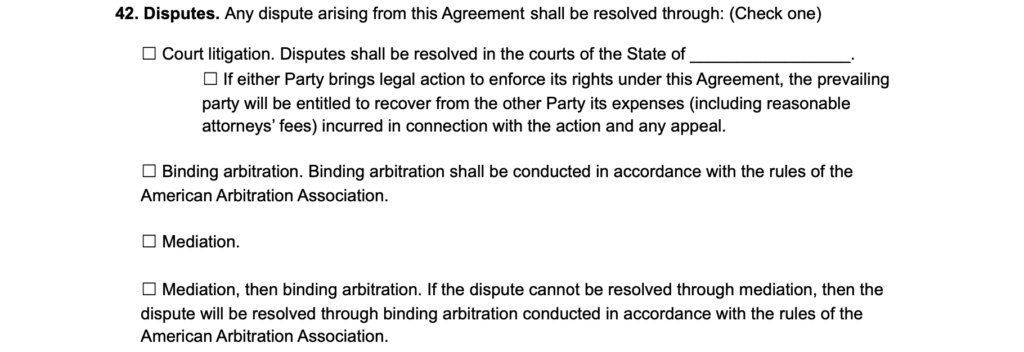
Provide for any other provisions not already included in this agreement.

Use the sample form below to create a land lease agreement or customize a form with our document builder.